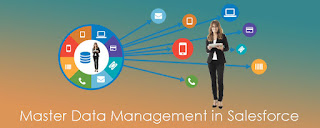Data is at the center of everything you are doing in your
business. it's additionally the engine that drives your Salesforce instance.
Without it, however, might you establish wherever to speculate your resources or
World Health Organization your high performer's ar inside the company? however, might you ever be ready to build the correct decisions?
Business selections trust heavily on knowledge and metrics. it's
essential to properly and firmly manage your knowledge to facilitate educated
decision-making. Old, unmanaged and poor quality knowledge will mean you're
running your business on an awfully rusty and shady engine. Imagine the
repercussions of duplicate client records in your reports, or unreliable
opportunities in your sales funnel or worse, however, inaccurate quarter-end
metrics. thus whether or not you're migrating knowledge from an inheritance the system, building reports to share with management groups, coming up with
territories, and assignment sales quotas, or reaching intent on customers to
create relationships - you have got to make sure that account, lead, contact
and client knowledge is correct, clean, and complete.
But wherever does one start? Here are 3 key steps to making a solid foundation on that to create reportage complexities without worrying of
poor knowledge quality:
Step 1: Assess and manage this
state of information quality
Data.com knowledge quality assessment could be fast and simple
methodology to induce a visible illustration of your CRM knowledge quality. Not
solely does one get a report that helps you to analyze your account, contact,
and lead records, to achieve details on knowledge completeness and quality-
you'll be able to additionally set up a 1 on one consultation with a licensed
Specialist. With the info.com knowledge Quality Assessment Accelerator*, the A specialist can offer best practices and work with you to assess and improve the
standard of your knowledge.
Duplicate records are operated of human error and generally
programmatic flaws. But, having duplicates inside Salesforce online training is painful and
will price thousands of bucks to scrub up. Organizations don't even understand
however incomplete or out of date, their knowledge is, unless they need to
mix it for management reportage. Salesforce dupe management is another nice
feature that enables you to spot duplicate records similarly to stop future
duplicate records from being created. would you like to facilitate duplicate
management? investigate the stop Duplicate Records Accelerator. With the
assistance of our consultants, you’ll learn to activate and tack Duplicate
Management to stop redundancies before they happen.
Step 2: verify key metrics and
build helpful dashboards
One a part of the equation is to possess the correct knowledge the quality however the second, equally vital half, is to possess the correct
dashboards. having the ability to assess the health of your sales, campaigns or
client base in an exceedingly fast look and even whereas on the go - might
build the distinction between meeting your business goals and missing them!
For sales groups, here are some key metrics to consider:
• Time to shut
• Opportunity pipe
• Forecast by rep,
forecast by stage
• Activities by
sales rep
• Win/loss rates
For service groups, these
metrics are should-haves:
• Time to case
resolution
• Cases by supply
• High severity
case volume
• Top customers by
open case
• Case volume
trend
Marketing groups cannot operate
without:
• Leads by supply
/ campaign
• Campaigns by
region
• Campaign
conversion funnel
• Pipeline
• Top revenue
generating campaigns
Need to facilitate building or optimizing your dashboards for any
of the on top of use cases? investigate these Accelerators that may offer
consultants World Health Organization will guide you thru established best
practices for building and customizing reports and dashboards.
Sales Cloud Dashboard
Service Cloud Dashboard
Sales Cloud selling Dashboard
Step 3: Build 360-degree read of
your client knowledge
Your business runs on client knowledge – it's your competitive
advantage, driving investment and business selections, establishing sales and
selling priorities, and impacting the standard of your relationships together
with your most vital accounts. Incomplete or disjointed knowledge could be a
essential liability.
360 degree read of your customer: delivery knowledge across
multiple sources within the enterprise, combining/enriching it with third-party
knowledge, then cleansing and matching all knowledge sets to make one read.
whereas there are successes, for many this has been a posh, pricey endeavor
that does not mirror the class, ease-of-use, and measurability of salesforce
cloud applications. Today’s master knowledge management brings knowledge along
within the cloud, not solely managing client profiles, however combining a
limitless variety of entities like the product, price, locations, and relating all
of them along in powerful hierarchies and affiliations. you would like to use
powerful new huge knowledge technologies, kind of like those won't to power
Facebook and LinkedIn applications, to mix interactions and transactions,
together with social knowledge, delivering associate panoptic read for relevant
insights and counseled actions.
Building a master knowledge management strategy will be a frightening task, then we've designed multiple Accelerators to assist you
quickly establish a roadmap and establish the simplest approach to assembling
one read of client knowledge. client Master knowledge Harmonization
Accelerator* can assist you to establish associate enterprise knowledge management the framework that focuses on higher managing of client knowledge, enabling you to attain most price across your enterprise
design. Salesforce training Integration Patterns summary associated design can provide
your team a skilled diode summary of Salesforce integration capabilities thus
you'll be able to seamlessly integrate Salesforce with different enterprise
applications and manage knowledge a lot of effectively.
Accelerators are quick, centered engagements with certified
Specialists World Health Organization can offer best practices, steering and
active support to assist you to reach your goals
Want to listen to a lot of regarding best practices around
knowledge management? be a part of this webinar.


















